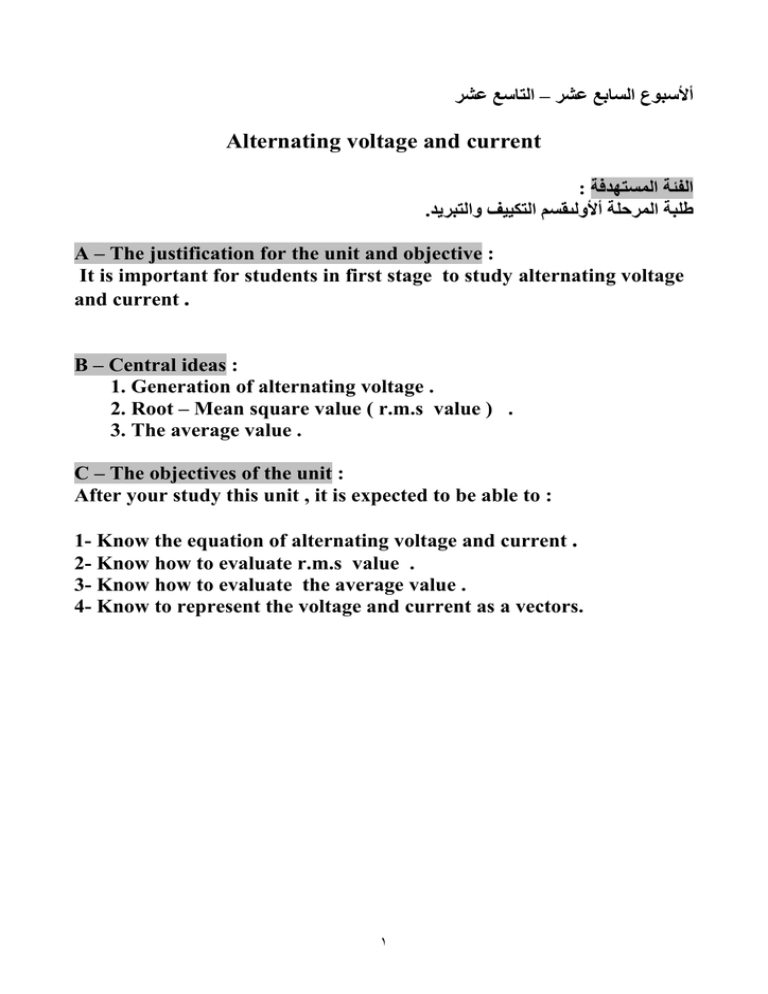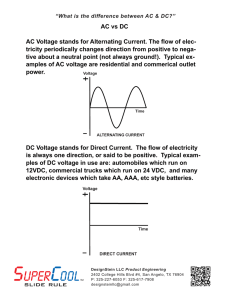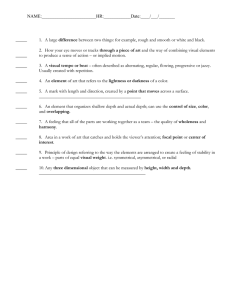Alternating voltage and current
advertisement

أألسبوع السابع عشر – التاسع عشر
Alternating voltage and current
: الفئة المستھدفة
.طلبة المرحلة أألولٮقسم التكييف والتبريد
A – The justification for the unit and objective :
It is important for students in first stage to study alternating voltage
and current .
B – Central ideas :
1. Generation of alternating voltage .
2. Root – Mean square value ( r.m.s value ) .
3. The average value .
C – The objectives of the unit :
After your study this unit , it is expected to be able to :
1- Know the equation of alternating voltage and current .
2- Know how to evaluate r.m.s value .
3- Know how to evaluate the average value .
4- Know to represent the voltage and current as a vectors.
١
Alternating voltage
Generation of alternating voltage :
Alternating voltage may be generated by rotating a coil in a magnetic
field as shown in fig. 1 or by rotating magnetic field within a
stationary coil as shown in fig. 2 .
The value of voltage generated depends upon the followings :
٢
1. Number of turns of coil .
2. Strength of the magnetic field .
3. Speed of rotation .
Equation of the alternating voltage and current :
Consider a rectangular coil having ( N ) turns and rotating in a
uniform magnetic field with an angular velocity of ( w ) as shown in
fig. 3 .
Maximum flux ( Φ m ) is linked with the coil when its plan coincidens
with the x – axis . For different values of ( wt ) the effective
component is
Φ = Φ m cos wt
According to Faradays laws , the instantaneous value of the induced
e.m.f is
d
e = - ---- ( N Φ )
٣
dt
d
e = - N ----- ( Φ m cos wt )
dt
e = - N Φ m w ( - sin wt )
e = w N Φ m sin wt
e has maximum value when wt = 90 , since sin 90 = 1 .
Em=wNΦm
Therefore , for resistive load :
e = E m sin wt
i = I m sin wt
it is seen that the induced e.m.f varies as a sin function with wt as
shown in fig. 4 .
Root – Mean square value ( r.m.s value ) :
٤
It is also known as the effective value of the voltage or current . There
are two methods for finding this value .
1. Mid – ordinate method : In this method , the wave is divided to
n equal intervals
V r.m.s
=
V12 + V 22 + V 32 + − − − − + V n2
n
2. Analytic method :
T
V r.m.s =
∫ v 2( t ) dt
0
T
T
I r.m.s =
∫ i 2( t ) dt
0
T
In case of symmetrical sinusoidal wave :
V r.m.s = 0.707 V m
I r.m.s = 0.707 I m
٥
Example : Find the effective value ( r.m.s value ) of the waveform
shown in fig. 5 .
Vr.m.s =
( 4 2 x 2 ) + (−1) x 4
= 1.58 v
8
The average value :
٦
The average value of alternating current is expressed by the steady
current which flow through any circuit .
T
Iav = ∫
i ( t ) dt
T
0
T
Vav = ∫
0
v ( t ) dt
T
Average value =
Algebraic sum of areas
------------------------------------Length of wave
Example : Find the average value of voltage for the wave in fig. 5 .
V av
( 2 x 4 ) + { ( -1 ) x ( 8 – 4 ) }
= ----------------------------------------- = 0.5 v
8
In case of symmetrical sinusoidal wave :
V av = 0.637 Vm
I av = 0.637 Im
Form factor : It is defined as the ratio between the r.m.s value and
the average value .
٧
r.m.s value
Kf = ---------------------average value
Where Kf is the form factor .
In case of symmetrical sinusoidal wave :
0.707 Vm
Kf = ---------------- = 1.11
0.637 Vm
0.707 Im
Kf = ---------------- = 1.11
0.637 Im
Vector representation of alternating voltage and current :
Alternating voltage and current can be represented by a vector . A
vector quantity is a physical quantity which has magnitude as well as
direction . The length of the line represents the magnitude of
alternating quantity , the inclination of the line with respect to some
axis of reference gives the direction in which the quantity acts .
Phase difference :
For two or more alternating quantities , one quantity may leads or
lags the other quantities by definite angle . A leading alternating
٨
quantity is one which reaches its maximum or zero value earlier as
compared to the other quantity .
Similarly , a lagging alternating quantity is one which reaches its
maximum or zero value later than the other quantity . Fig. 42 shows
alternating quantities ( A ) and ( B ) , in this figure , the alternating
quantity (B) leads alternating quantity (A) by angle θ .
Fig.42
Example : Draw the waveform for the followings :
A-
B-
i 1 = 7 sin wt
,
i 2 = 10 sin ( wt + π / 3 )
v = 70 sin (wt + 90 )
,
i = 50 sin (wt – 45)
٩
١٠






